Winter is a very good time of year to visit the Norfolk Broads. In preparation for the regular Winter Tours planned to explore the area in early 2016, we have made several visits in recent weeks. We had a very good day in the Broads last Monday.
We started with a stop near Sea Palling to catch up with a Cattle Egret which had been hanging around appropriately with the local cattle. It looked slightly incongruous here on a damp, misty December morning. More at home in southern Europe, Cattle Egret has been rather slower to expand its range northwards than its cousin, the Little Egret. There is a shortage of cattle outside at this time of year, which presumably does not help encourage them to hang around.
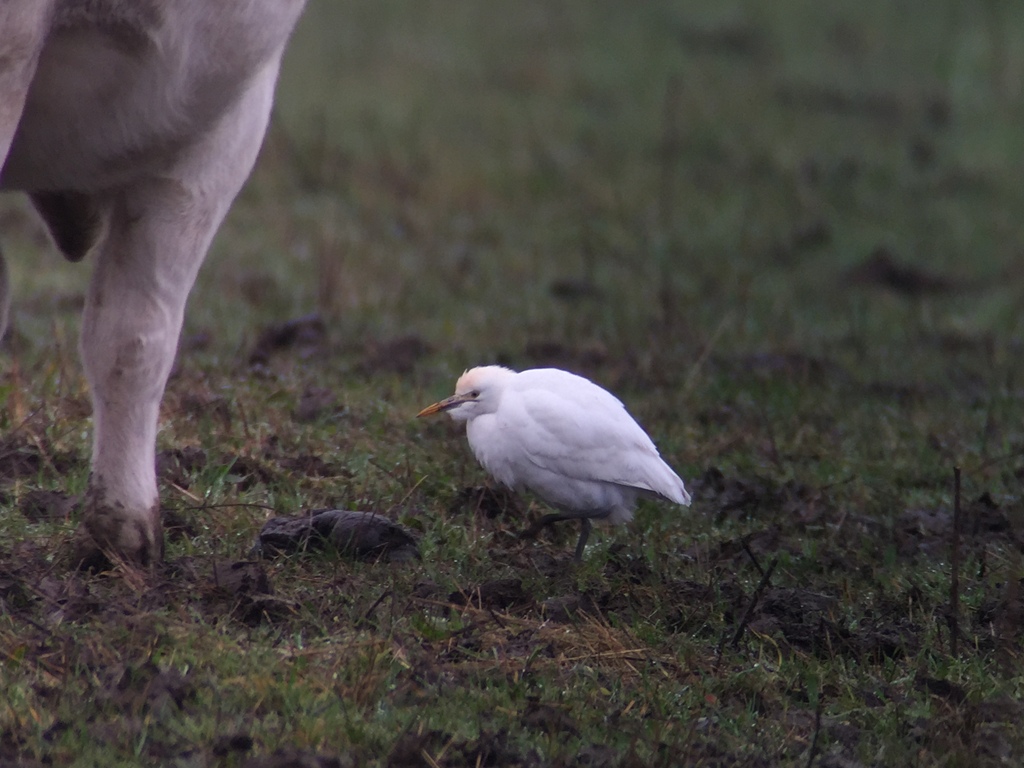 Cattle Egret – feeding in the mud amongst the cattle
Cattle Egret – feeding in the mud amongst the cattle
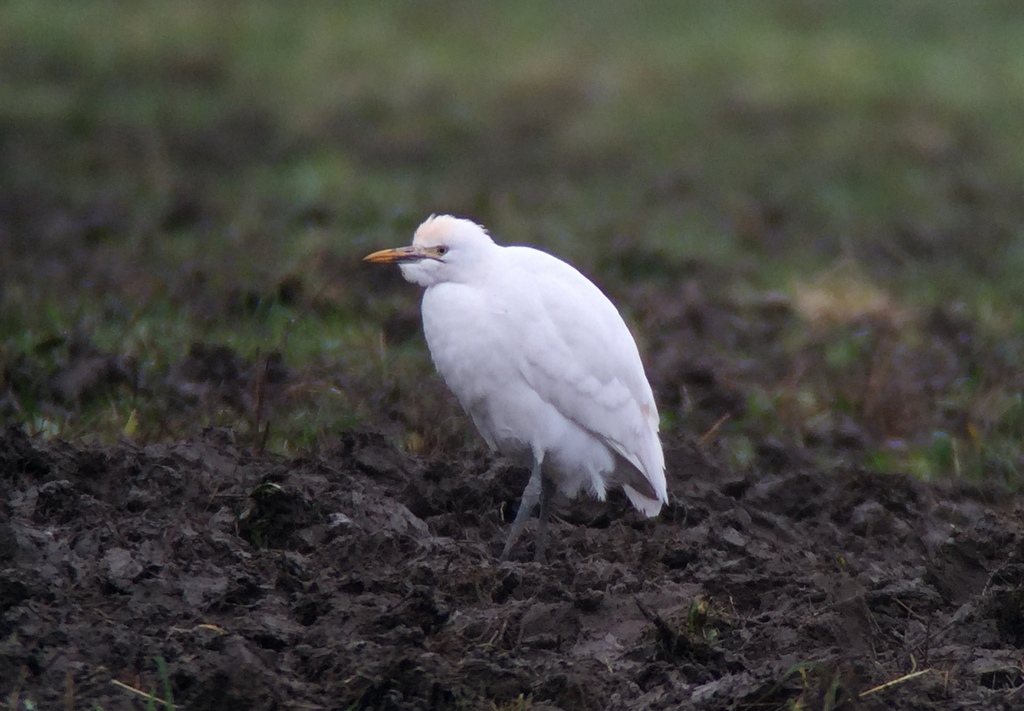 Cattle Egret – muddy yellow bill and just a smudge of an orange crown
Cattle Egret – muddy yellow bill and just a smudge of an orange crown
Some video of the Cattle Egret feeding in with the cattle can be seen below.
One of the highlights of a visit to the Broads at this time of the year is a chance to catch up with the regular wintering herd of wild swans. Numbers always tend to increase through the winter, but the mild weather has perhaps meant this has been a little slow this year as birds have probably remained on the continent longer than normal. They do seem to be on the increase now, with at least 45 on Monday, a mixture of Bewick’s Swans and Whooper Swans.
It is always good to be able to see the two species side by side. Bewick’s Swans are noticeably smaller with less extensive yellow on the bill; the yellow on the bill of Whooper Swan also extends further down the bill forming a sharper point, compared to the blunter, more squared off yellow on Bewick’s Swans.
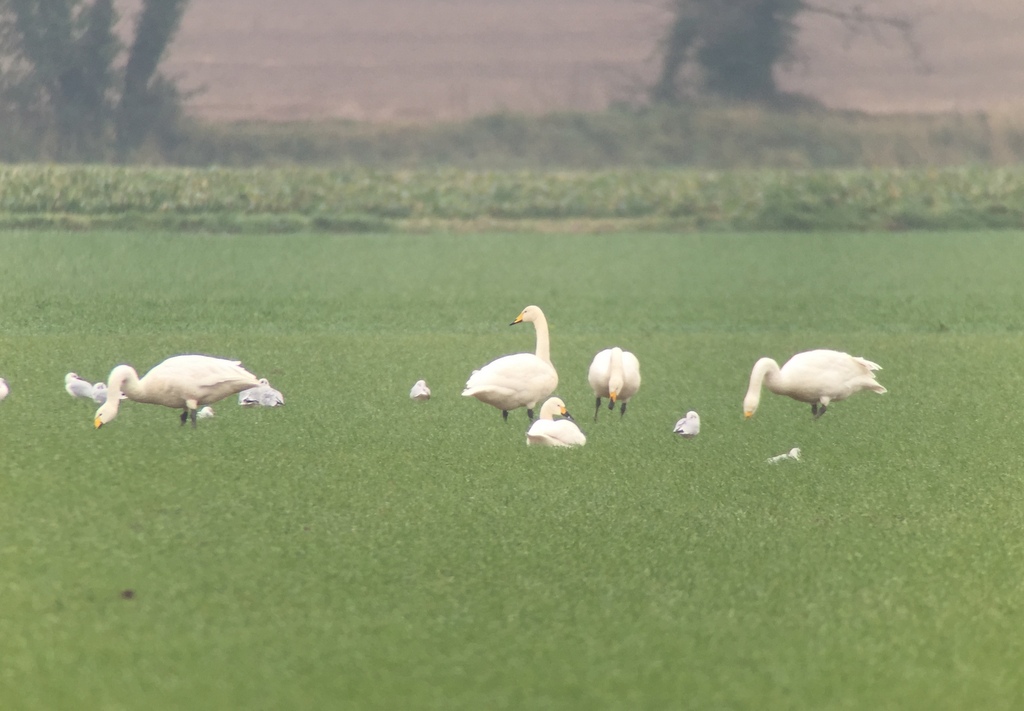 Whooper & Bewick’s Swans – part of the regular mixed herd in the Broads
Whooper & Bewick’s Swans – part of the regular mixed herd in the Broads
 Bewick’s Swan – flanked by two Whooper Swans
Bewick’s Swan – flanked by two Whooper Swans
The Broads are also a great place to catch up with a variety of different species of geese. There are lots of Pink-footed Geese here for the winter, perhaps not surprisingly given the variety of food available – extensive grazing marshes and also lots of sugar beet tops after the harvest. There is still a lot of sugar beet grown here, with Cantley Beet Factory being one of the main sites for processing it once it has been harvested. Cantley and Buckenham Marshes are also good sites for White-fronted Geese, with peak counts of over 120 already in recent weeks.
However, the real speciality here are the Taiga Bean Geese. There are only two regular wintering sites for this (sub)species in the UK, the Yare Valley in Norfolk and the Slamannan plateau in southern Scotland, and they are remarkably site faithful returning to the same area year after year from their breeding grounds in Sweden. It didn’t take us long to find them today – just as we arrived at Cantley a flock of around 20 Taiga Bean Geese flew in to feed on the grazing marshes. Very helpful timing!
A couple of weeks ago, a more thorough exploration of the area was required to find them and had located two Taiga Bean Geese on their own at Buckenham and a flock of 20+ at neighbouring Cantley, which was when the following photos were taken. Tundra Bean Geese, the other form of Bean Goose we get here, winter mainly on the continent and are occasional visitors, often among the vast flocks of Pink-footed Geese. The Taiga Bean Geese are slightly larger, longer-necked and have on average more extensive orange colouration on their longer bills. It is interesting to look at the variation in bill pattern between individuals.
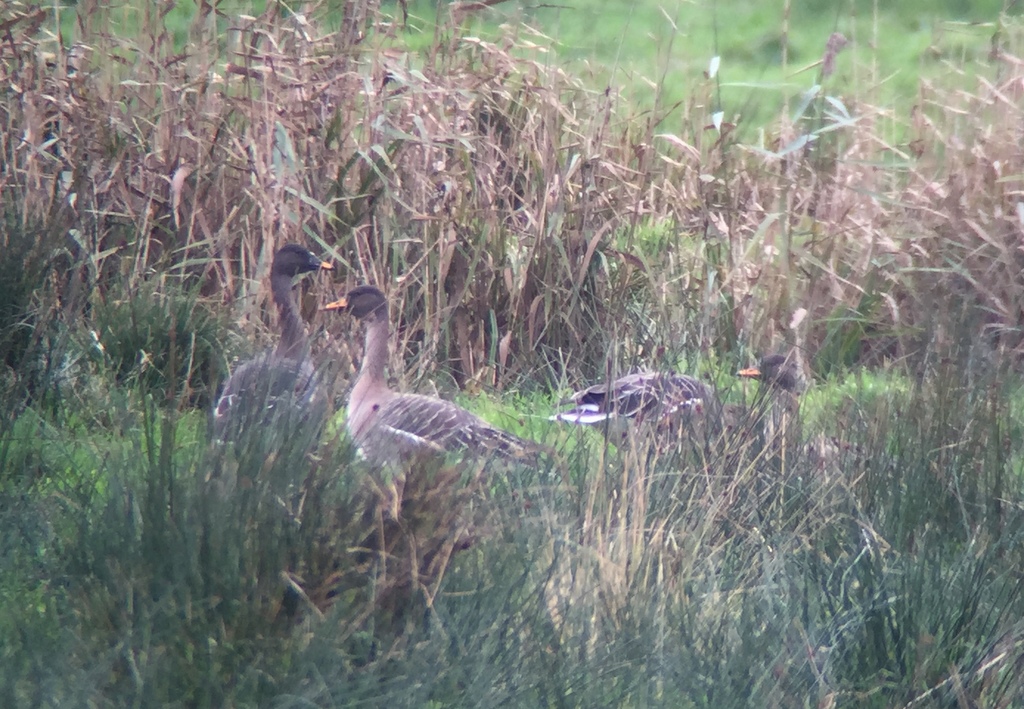
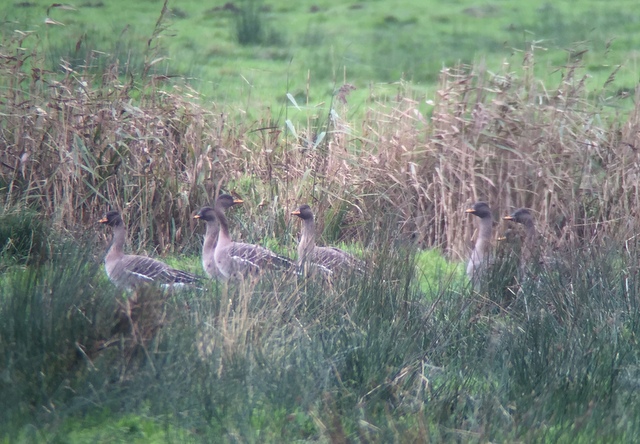
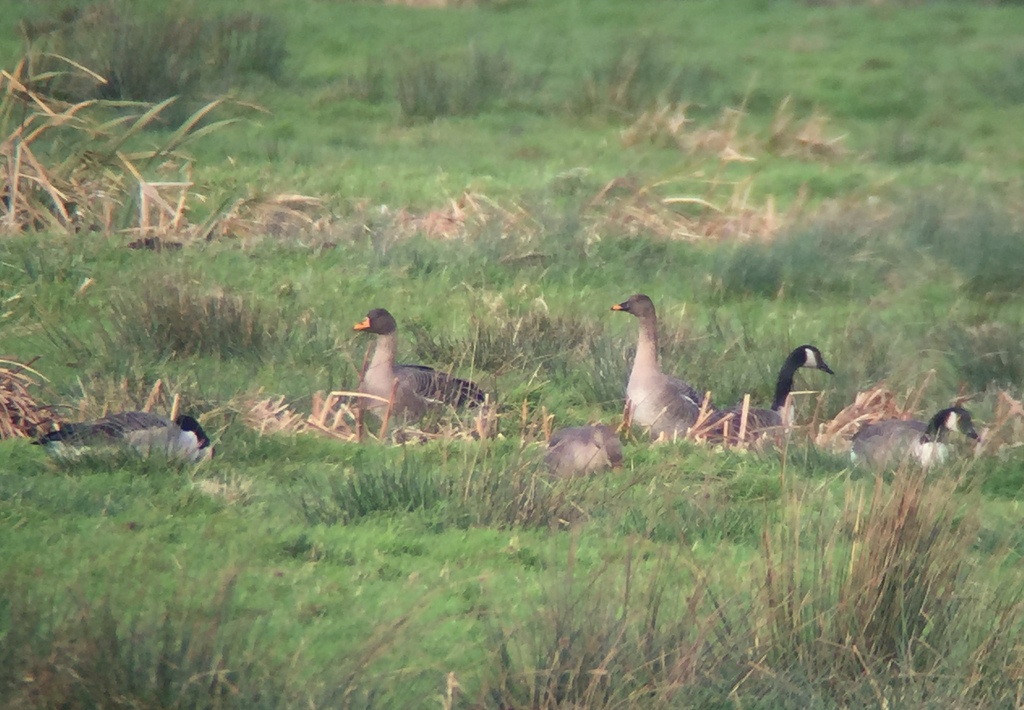 Taiga Bean Geese – part of the regular wintering flock
Taiga Bean Geese – part of the regular wintering flock
Cranes are also one of the iconic species we look for in the Broads, also known as Common or Eurasian Cranes. Our birds are not to be confused with those being reintroduced into Somerset. While Cranes were wiped out as a breeding species in the UK in the 17th Century, a pair first returned to the Norfolk Broads of their own accord in 1979 and breeding was first recorded in 1982. The population of Cranes here has grown steadily from there.
We had no problem finding Cranes today – we came across at least 14 on our travels. First we found two family parties feeding distantly out on the fields – one pair of adults were accompanied by two juveniles and the other pair were with a single youngster. Next, we stopped at a favourite feeding area and as we pulled off the road we realised that a pair of Cranes were right next to the car. They immediately started to walk away, and as they did so we realised that a third Crane was nearby. We stayed in the car and once they got out into the middle of the field they seemed to relax and resume feeding.
The larger of the pair was carrying an old corn cob, possibly a male and following what appeared to be a smaller female. At one point, he raised his wings and leapt into the air in what was presumably a little piece of dance display. Great to watch.
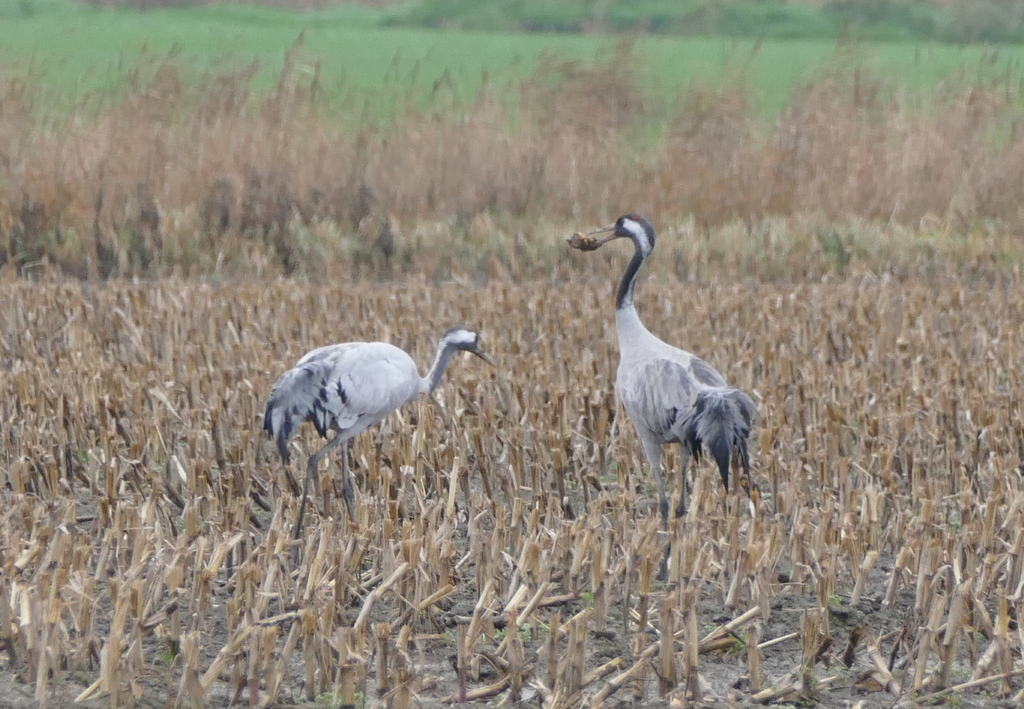
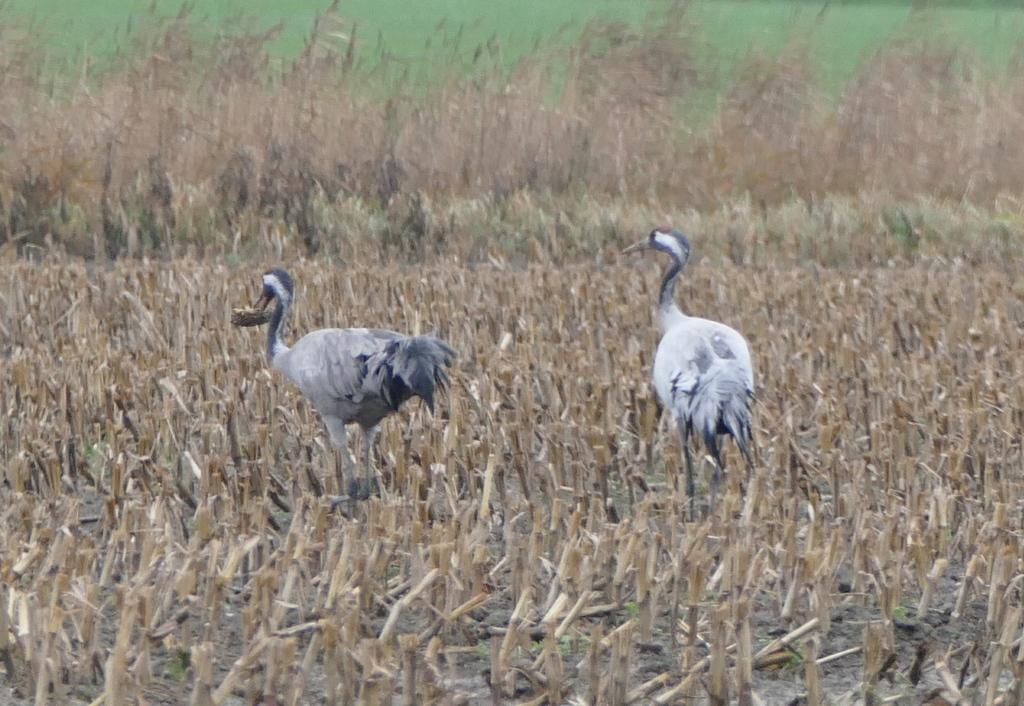 Cranes – this pair were in a field right next to the road
Cranes – this pair were in a field right next to the road
We also had time today to explore some different parts of the Broads, which we don’t visit so often. As well as more Cranes, there were several Marsh Harriers enjoying the afternoon sunshine. We came across several little groups of winter thrushes feeding on berries, Fieldfares and Redwings. A Water Pipit flew up from the edge of a flooded field.
A visit to Stubb Mill is a great way to end the day in the Broads. There is a very large harrier roost here and it is always an impressive sight to see so many Marsh Harriers. There were already quite a few out in the bushes in the reeds when we arrived, so it was hard to say how many were in the roost today. We counted at least 30 at one point, with more still arriving. A ringtail Hen Harrier was using the last of the afternoon to hunt and came in low across the grazing marsh in front of us.
An early Barn Owl was out hunting as well and lots of Fieldfares and Redwings were in the hedgerows. This is also a good place to find Cranes and there is generally a pair hanging around the fields here. Unfortunately, we had to leave slightly early this afternoon but it was still suitably evocative to walk back listening to the bugling of the pair of Cranes, and a lovely way to finish the day.
 Stubb Mill viewpoint – the view across the marshes earlier in the year
Stubb Mill viewpoint – the view across the marshes earlier in the year
Tours to the Broads will run regularly through January and February 2016. If you would like to join us to look for the Cranes, geese, swans and raptors and enjoy the unique scenery, please get in touch.
















